-
Countries
-
Data and Analysis
-
Special Focus
-
Crisis Responses
Compilation/Overview
Color
white
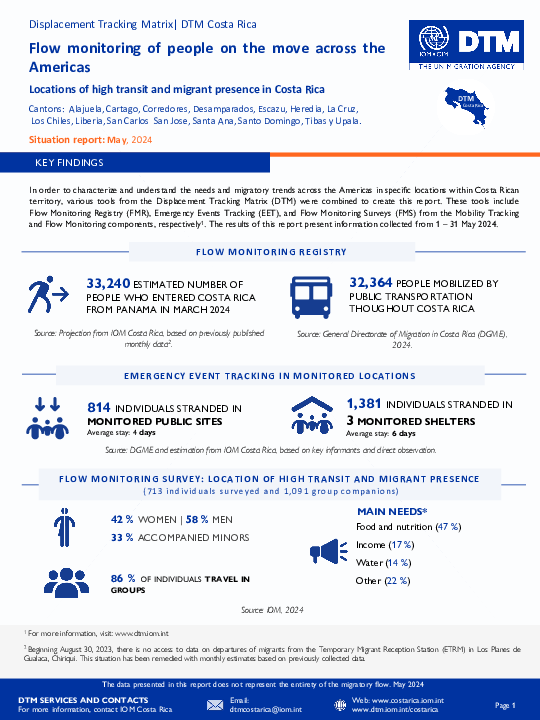
Contact
DTMCostaRica@iom.int
Language
English
Location
Costa Rica
Period Covered
May 01 2024
May 31 2024
Activity
- Survey
- Registration
- Flow Monitoring
- Mobility Tracking
Cantons: Alajuela, Alajuela, Cartago, Corredores, Desamparados, Escazu, Heredia, La Cruz, Los Chiles, Liberia, San Carlos San Jose, Santa Ana, Santo Domingo, Tibas y Upala
Costa Rica, like other Central American countries, has been characterized as a migratory corridor for the flow of people in mobility through the Americas. This flow is mainly composed of people from the Bolivarian Republic of Venezuela, Cuba, Haiti, Ecuador, as well as from other countries in South America, Africa, and Asia. According to estimates from IOM Costa Rica, during May 2024, approximately 33,240 people entered the country, with a daily average of 1,072 people. This represents a 7% increase compared to April 2024. Additionally, 814 people were identified as stranded in monitored public places and 1,381 people stranded in monitored shelters.

Contact
Angélica Madrigal amadrigal@iom.int
Language
English
Location
Costa Rica
Period Covered
May 01 2024
May 31 2024
Activity
- Survey
- Registration
- Flow Monitoring
Cantons: Alajuela, Alajuelita, Cartago, Desamparados, Escazú, Corredores, Heredia, Los Chiles, San Carlos, San José, Santa Ana, Santo Domingo, Tibás
Costa Rica, al igual que otros países de América Central, se ha distinguido por ser un corredor migratorio del flujo en situación de movilidad por las Américas. Este flujo está compuesto principalmente por personas provenientes de la República Bolivariana de Venezuela, Cuba, Haití, Ecuador, así como de otros países de Suramérica, África y Asia. Según estimaciones de la OIM Costa Rica, durante mayo de 2024 ingresaron al país aproximadamente 33.240 personas, con un promedio diario de 1.072 personas. Esto representa un aumento del 7% en comparación con abril de 2024. Además, se identificaron 814 personas varadas en los sitios públicos monitoreados y 1.381 personas varadas en los albergues monitoreados.
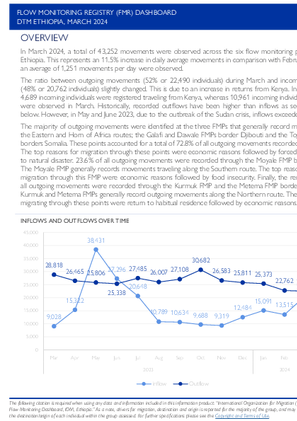
Contact
DTM Ethiopia, DTMEthiopia@iom.int
Language
English
Location
Ethiopia
Period Covered
Mar 01 2024
Mar 31 2024
Activity
- Flow Monitoring
In March 2024, a total of 43,252 movements were observed across the six flow monitoring points (FMPs) in Ethiopia. This represents an 11.5% increase in daily average movements in comparison with February 2024 when an average of 1,251 movements per day were observed.
The ratio between outgoing movements (52% or 22,490 individuals) during March and incoming movements (48% or 20,762 individuals) slightly changed. This is due to an increase in returns from Kenya. In February 2024, 4,689 incoming individuals were registered traveling from Kenya, whereas 10,961 incoming individuals from Kenya were observed in March. Historically, recorded outflows have been higher than inflows as seen in the figure below. However, in May and June 2023, due to the outbreak of the Sudan crisis, inflows exceeded outflows.
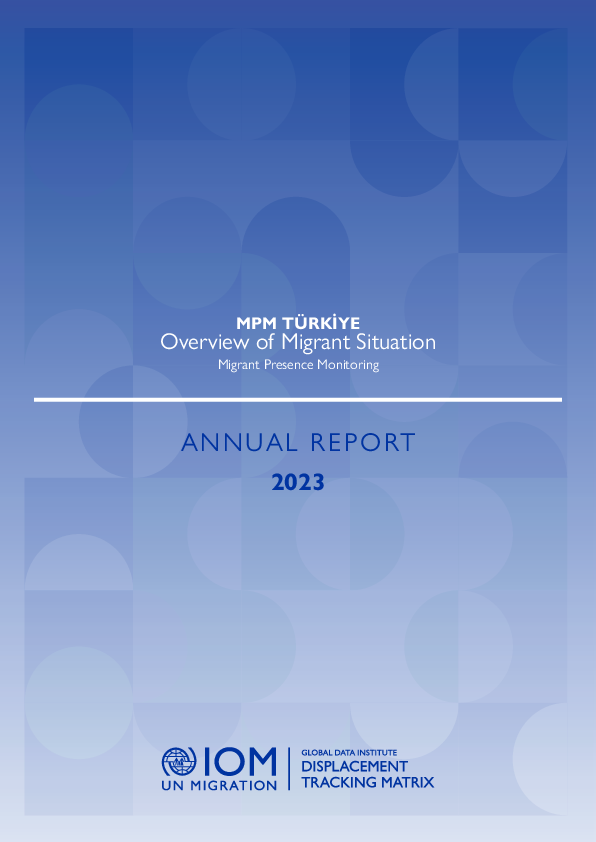
Contact
DTM Türkiye, mpmturkey@iom.int
Language
English
Location
Republic of Türkiye
Period Covered
Jan 01 2023
Dec 31 2023
Activity
- Flow Monitoring
- Migrants presence
According to the latest figures from the Turkish Presidency of Migration Management (PMM), there are more than 4.6 million foreigners in Türkiye, of whom 3.5 million are seeking international protection. Most of them are Syrians (3,214,780 individuals: 3,150,899 urban caseload and 63,881 residing in camps) who have been granted temporary protection status. There is an increase of 16,356 individuals in the number of Syrian nationals staying in camps in comparison to last year's figures.
According to the United Nations High Commissioner for Refugees (UNHCR), there were 296,685 refugees and asylum-seekers in Türkiye as of mid of 2023.
In addition, 1,107,032 foreigners present in Türkiye holding residency permits including short-term residence permit, family residence permit, student residence permit, longterm residence permit, humanitarian residence permit and residence permit for victims of human trafficking.
According to PMM, 254,008 migrants in an irregular situation of different nationalities were apprehended in Türkiye in 2023.4 Please see Page 4 for more details.
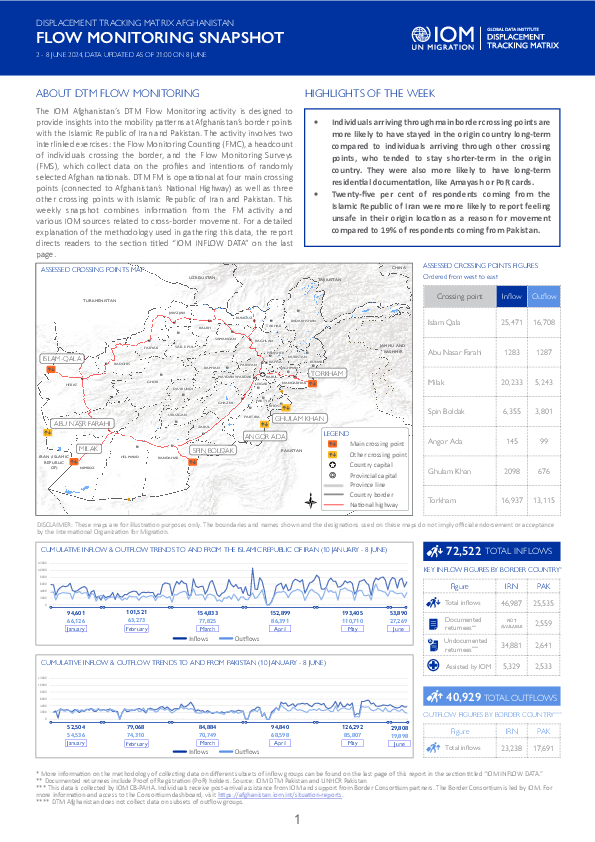
Contact
DTMAfghanistan@iom.int
Language
English
Location
Afghanistan
Period Covered
Jun 02 2024
Jun 08 2024
Activity
- Survey
- Flow Monitoring Survey
- Flow Monitoring
The IOM Afghanistan’s DTM Flow Monitoring activity is designed to provide insights into the mobility patterns at Afghanistan’s border points with the Islamic Republic of Iran and Pakistan. The activity involves two interlinked exercises: the Flow Monitoring Counting (FMC), a headcount of individuals crossing the border, and the Flow Monitoring Surveys (FMS), which collect data on the profiles and intentions of randomly selected Afghan nationals. DTM FM is operational at four main crossing points (connected to Afghanistan’s National Highway) as well as three other crossing points with Islamic Republic of Iran and Pakistan. This weekly snapshot combines information from the FM activity and various IOM sources related to cross-border movement. For a detailed explanation of the methodology used in gathering this data, the report directs readers to the section titled “IOM INFLOW DATA” on the last page.
UNHCR and IOM Joint Annual Overview 2023
In 2023, an estimated 212,100 attempts were reported by migrants and refugees to cross the Central Mediterranean Sea from Algeria, Libya, and Tunisia to Europe. This was a 33% increase compared to known departures in 2022.
Of those who attempted to depart in 2023, 71% (151,500) were disembarked in Europe, while 29% (60,600) were rescued or intercepted and disembarked in North Africa (21% in Tunisia, 8% in Libya).
In 2023, more than 3,105 migrants and refugees are known to have lost their lives or gone missing at sea while attempting to cross to Europe along the three Mediterranean routes (eastern, central and western Mediterranean), an increase compared to more than 2,500 deaths recorded in 2022. 61% of the deaths in 2023 took place on the central Mediterranean Sea. According to IOM’s Missing Migrants Project, more than 700 deaths occurred off the coast of Tunisia, more than 680 off Libya and more than 460 off Italian shores. The increasing number and proportion of deaths off the coast of Tunisia is unprecedented in the last 10 years. Notably, more than 1,9008 deaths in the central Mediterranean Sea in 2023 were linked to mass shipwrecks involving the loss of more than 20 lives at sea. However, the real number of dead and missing along these routes is believed to be higher as many incidents go unreported or undetected.
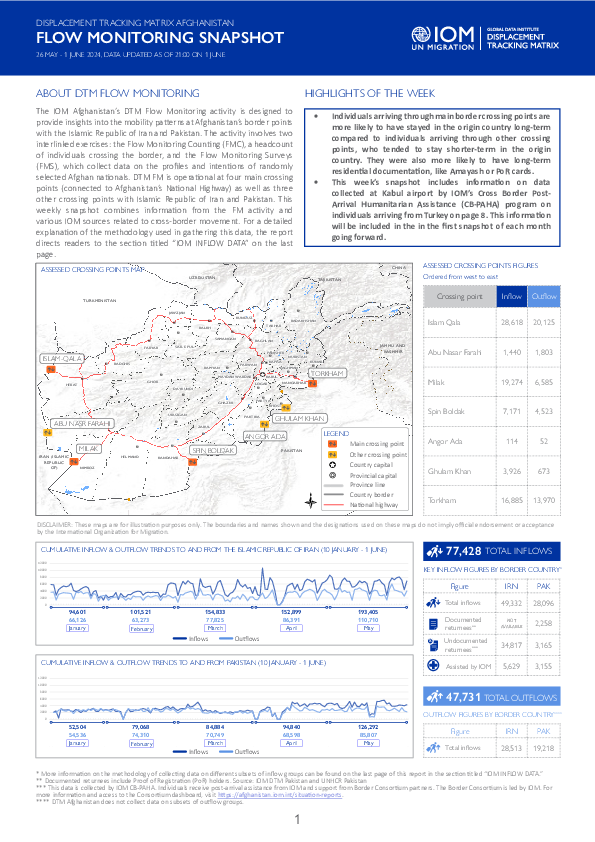
Contact
DTMAfghanistan@iom.int
Language
English
Location
Afghanistan
Period Covered
May 26 2024
Jun 01 2024
Activity
- Survey
- Flow Monitoring Survey
- Flow Monitoring
The IOM Afghanistan’s DTM Flow Monitoring activity is designed to provide insights into the mobility patterns at Afghanistan’s border points with the Islamic Republic of Iran and Pakistan. The activity involves two interlinked exercises: the Flow Monitoring Counting (FMC), a headcount of individuals crossing the border, and the Flow Monitoring Surveys (FMS), which collect data on the profiles and intentions of randomly selected Afghan nationals. DTM FM is operational at four main crossing points (connected to Afghanistan’s National Highway) as well as three other crossing points with Islamic Republic of Iran and Pakistan. This weekly snapshot combines information from the FM activity and various IOM sources related to cross-border movement. For a detailed explanation of the methodology used in gathering this data, the report directs readers to the section titled “IOM INFLOW DATA” on the last page.
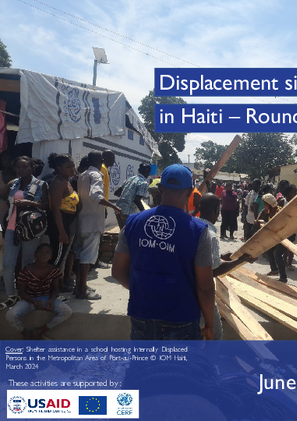
Contact
DTM Haiti, dtmhaiti@iom.int
Language
English
Location
Haiti
Period Covered
Apr 24 2024
May 31 2024
Activity
- Mobility Tracking
- Baseline Assessment
- Site Assessment
- Village Assessment
The Round 6, published in early March 2024, indicated that 362,551 people were
internally displaced in Haiti. This new Round indicates the presence of 578,074 internally displaced people, almost 60%
more than in Round 6. This increase is due to the deterioration of the security situation observed in the MAPAP, Haiti’s
capital, between the end of February and April 2024 in particular. The increase in the number of IDPs was more
identified in provinces where it increased by 95% (compared to 15% in the MAPAP). Indeed, following the increase in
violence in the MAPAP, many people fled the capital to seek refuge in provinces.
The Great South was the region that saw the largest increase in the number of IDPs hosted there (130% more
compared to Round 6). Nearly half (47%) of IDPs in the country are located in the Great South.
The majority of IDPs in the country are hosted in provinces: 68% in provinces vs. 32% in the MAPAP
The IDPs in provinces are mainly people who fled the MAPAP: 78% of IDPs in provinces came from the MAPAP.
Artibonite, where half of the IDPs fled areas located in this department, is an exception. In all other departments of the
country, IDPs mainly came from the MAPAP.
At the national level, the majority of IDPs are hosted by host families: 80% vs 20% in sites. However, in the MAPAP,
the majority of IDPs reside in sites (61% in sites vs 39% in host families), while in provinces the opposite is true (97% in
host families vs 3% in sites). It is crucial to support host communities in provinces, particularly in the Great South, to
enable them to continue hosting IDPs; and it is important to promote social cohesion between these two population
groups. Without the resilience of host communities, the number of sites in provinces is likely to increase as has been the
case in the MAPAP. Indeed, at the beginning of the crisis, the majority of IDPs in the MAPAP were hosted by host
families: only about 2 out of 10 IDPs were in sites in 2022; this figure increased to 6 out of 10 IDPs in 2023. One of the
main reasons for this increase was the lack of resources of host communities to continue hosting IDPs and the
deterioration of social cohesion in this context.
In addition, 50,000 returnees formerly IDPs were identified, particularly in the MAPAP, in Croix-des-Bouquets (21%),
Cité Soleil (14%), Port-au-Prince (12%); in the South in Tiburon (19%); and in the Center in Sauts d’Eau (10%). It should
be noted that for the moment these returns remain very fragile and are not sustainable, particularly in the MAPAP.

Contact
DTM Haiti, dtmhaiti@iom.int
Language
English
Location
Haiti
Period Covered
Feb 24 2024
May 31 2024
Activity
- Mobility Tracking
- Baseline Assessment
- Site Assessment
- Village Assessment
The Round 6, published in early March 2024, indicated that 362,551 people were
internally displaced in Haiti. This new Round indicates the presence of 578,074 internally displaced people, almost 60%
more than in Round 6. This increase is due to the deterioration of the security situation observed in the MAPAP, Haiti’s
capital, between the end of February and April 2024 in particular. The increase in the number of IDPs was more
identified in provinces where it increased by 95% (compared to 15% in the MAPAP). Indeed, following the increase in
violence in the MAPAP, many people fled the capital to seek refuge in provinces.
The Great South was the region that saw the largest increase in the number of IDPs hosted there (130% more
compared to Round 6). Nearly half (47%) of IDPs in the country are located in the Great South.
The majority of IDPs in the country are hosted in provinces: 68% in provinces vs. 32% in the MAPAP
The IDPs in provinces are mainly people who fled the MAPAP: 78% of IDPs in provinces came from the MAPAP.
Artibonite, where half of the IDPs fled areas located in this department, is an exception. In all other departments of the
country, IDPs mainly came from the MAPAP.
At the national level, the majority of IDPs are hosted by host families: 80% vs 20% in sites. However, in the MAPAP,
the majority of IDPs reside in sites (61% in sites vs 39% in host families), while in provinces the opposite is true (97% in
host families vs 3% in sites). It is crucial to support host communities in provinces, particularly in the Great South, to
enable them to continue hosting IDPs; and it is important to promote social cohesion between these two population
groups. Without the resilience of host communities, the number of sites in provinces is likely to increase as has been the
case in the MAPAP. Indeed, at the beginning of the crisis, the majority of IDPs in the MAPAP were hosted by host
families: only about 2 out of 10 IDPs were in sites in 2022; this figure increased to 6 out of 10 IDPs in 2023. One of the
main reasons for this increase was the lack of resources of host communities to continue hosting IDPs and the
deterioration of social cohesion in this context.
In addition, 50,000 returnees formerly IDPs were identified, particularly in the MAPAP, in Croix-des-Bouquets (21%),
Cité Soleil (14%), Port-au-Prince (12%); in the South in Tiburon (19%); and in the Center in Sauts d’Eau (10%). It should
be noted that for the moment these returns remain very fragile and are not sustainable, particularly in the MAPAP.
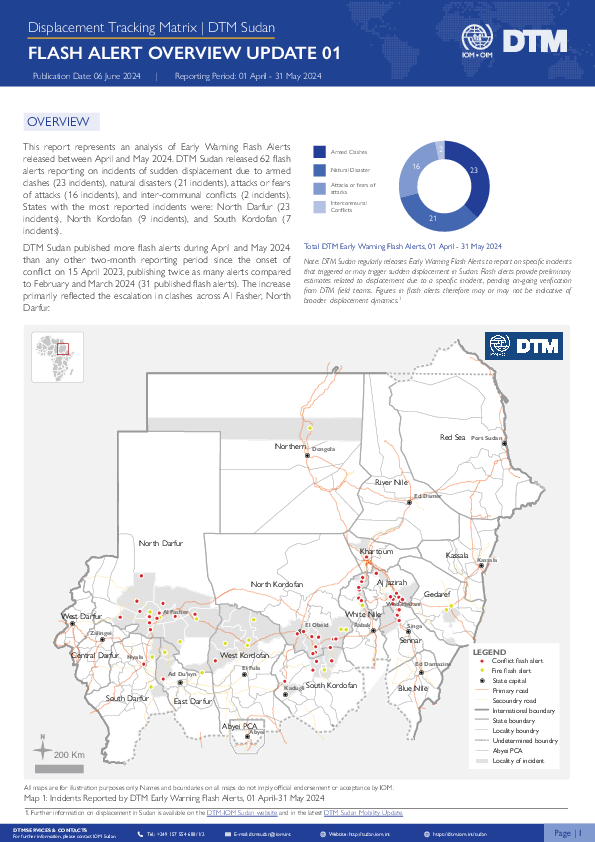
Contact
DTM Sudan; dtmsudan@iom.int
Language
English
Location
Sudan
Period Covered
Apr 01 2024
May 31 2024
Activity
- Mobility Tracking
- Event Tracking
This report represents an overview of DTM Early Warning Flash Alerts published between April and May 2024.
DTM Sudan released 62 flash alerts reporting on incidents of sudden displacement between April and May 2024, including incidents related to armed clashes (23 incidents), natural disasters (21 incidents), attacks or fears of attacks (16 incidents), and inter-communal conflicts (2 incidents). States with the most reported incidents were: North Darfur (23 incidents), North Kordofan (9 incidents), and South Kordofan (7 incidents).
Notably, DTM Sudan published more flash alerts during April and May 2024 than any other two-month reporting period since the onset of conflict on 15 April 2023, publishing twice as many alerts compared to February and March 2024 (31 published flash alerts). The increase primarily reflected the escalation in clashes across Al Fasher, North Darfur.
Note: DTM Sudan regularly releases Early Warning Flash Alerts to report on specific incidents that triggered or may trigger sudden displacement in Sudan. Flash alerts provide preliminary estimates of displacement figures due to a specific incidents. Figures in flash alerts therefore may or may not be indicative of broader displacement dynamics. More comprehensive information about displacement and mobility in Sudan is available in the Sudan Mobility Update. Early Warning Flash Alerts are distributed via the DTM Sudan mailing list.
Pagination
- Previous page
- Page 4
- Next page
